HLTENN008: Legal, Ethical Dimensions of Nursing Practice Assignment
VerifiedAdded on 2023/06/14
|11
|2399
|464
Homework Assignment
AI Summary
This assignment provides definitions and explanations of key legal and ethical concepts relevant to nursing practice. It covers ethical terms like ethics, bioethics, and nursing ethics, as well as ethical theories such as consequentialism and deontological ethics. Furthermore, it defines various legal terms including civil law, common law, statute law, precedent, law of torts, negligence, assault, battery, legal capacity, intellectual capacity, clinical incapacity, false imprisonment, defamation, vicarious liability, defendant, plaintiff, harassment, expert witness, and coronial inquests. The assignment also addresses the court hierarchy in Australia, sources of Australian legislation, requirements for valid patient consent, the role of the Coroner, and professional responsibilities of nurses. Finally, it discusses the application of autonomy, beneficence, non-malfeasance, justice, rights, and veracity in nursing practice. This document is available on Desklib, a platform offering a wide range of study resources for students.
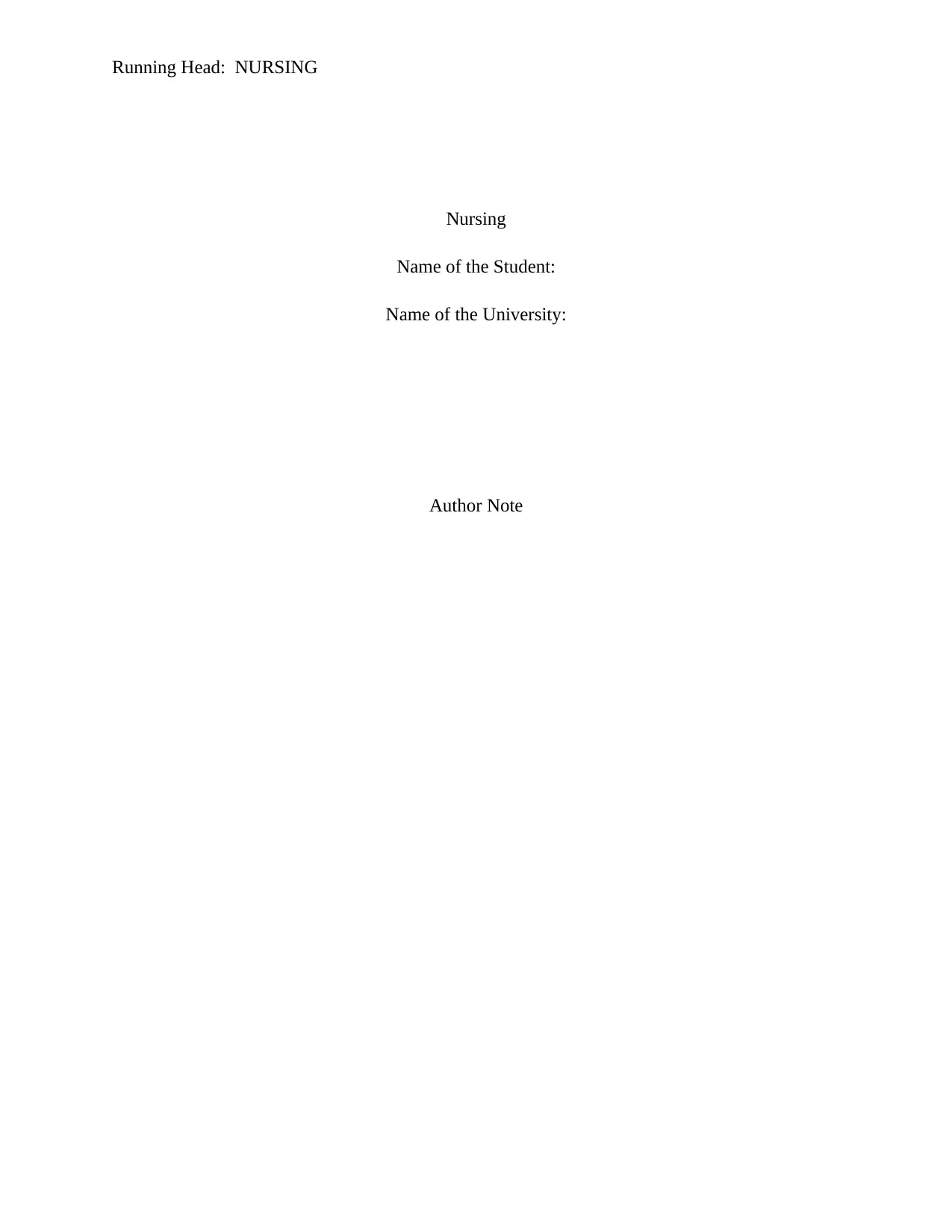
Running Head: NURSING
Nursing
Name of the Student:
Name of the University:
Author Note
Nursing
Name of the Student:
Name of the University:
Author Note
Secure Best Marks with AI Grader
Need help grading? Try our AI Grader for instant feedback on your assignments.
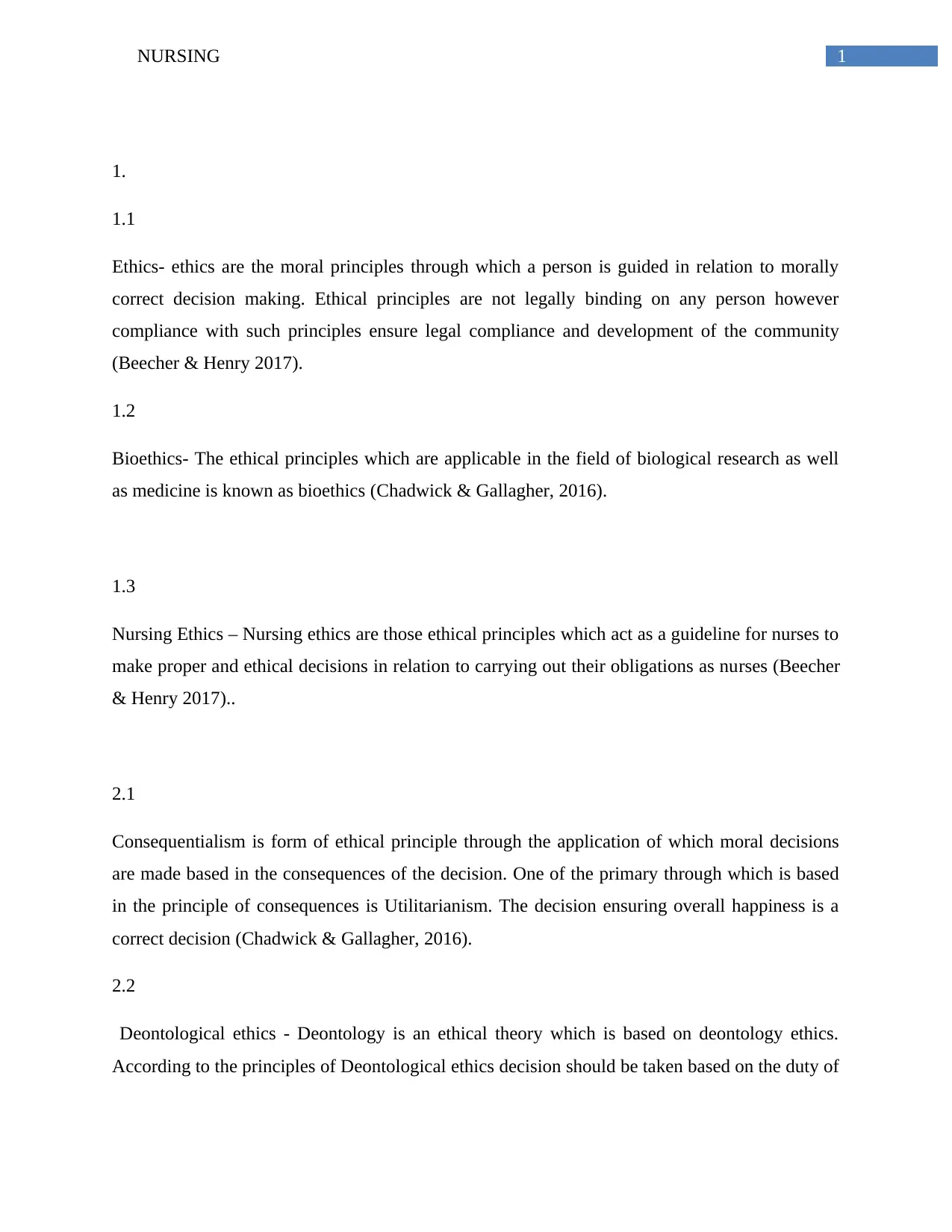
1NURSING
1.
1.1
Ethics- ethics are the moral principles through which a person is guided in relation to morally
correct decision making. Ethical principles are not legally binding on any person however
compliance with such principles ensure legal compliance and development of the community
(Beecher & Henry 2017).
1.2
Bioethics- The ethical principles which are applicable in the field of biological research as well
as medicine is known as bioethics (Chadwick & Gallagher, 2016).
1.3
Nursing Ethics – Nursing ethics are those ethical principles which act as a guideline for nurses to
make proper and ethical decisions in relation to carrying out their obligations as nurses (Beecher
& Henry 2017)..
2.1
Consequentialism is form of ethical principle through the application of which moral decisions
are made based in the consequences of the decision. One of the primary through which is based
in the principle of consequences is Utilitarianism. The decision ensuring overall happiness is a
correct decision (Chadwick & Gallagher, 2016).
2.2
Deontological ethics - Deontology is an ethical theory which is based on deontology ethics.
According to the principles of Deontological ethics decision should be taken based on the duty of
1.
1.1
Ethics- ethics are the moral principles through which a person is guided in relation to morally
correct decision making. Ethical principles are not legally binding on any person however
compliance with such principles ensure legal compliance and development of the community
(Beecher & Henry 2017).
1.2
Bioethics- The ethical principles which are applicable in the field of biological research as well
as medicine is known as bioethics (Chadwick & Gallagher, 2016).
1.3
Nursing Ethics – Nursing ethics are those ethical principles which act as a guideline for nurses to
make proper and ethical decisions in relation to carrying out their obligations as nurses (Beecher
& Henry 2017)..
2.1
Consequentialism is form of ethical principle through the application of which moral decisions
are made based in the consequences of the decision. One of the primary through which is based
in the principle of consequences is Utilitarianism. The decision ensuring overall happiness is a
correct decision (Chadwick & Gallagher, 2016).
2.2
Deontological ethics - Deontology is an ethical theory which is based on deontology ethics.
According to the principles of Deontological ethics decision should be taken based on the duty of
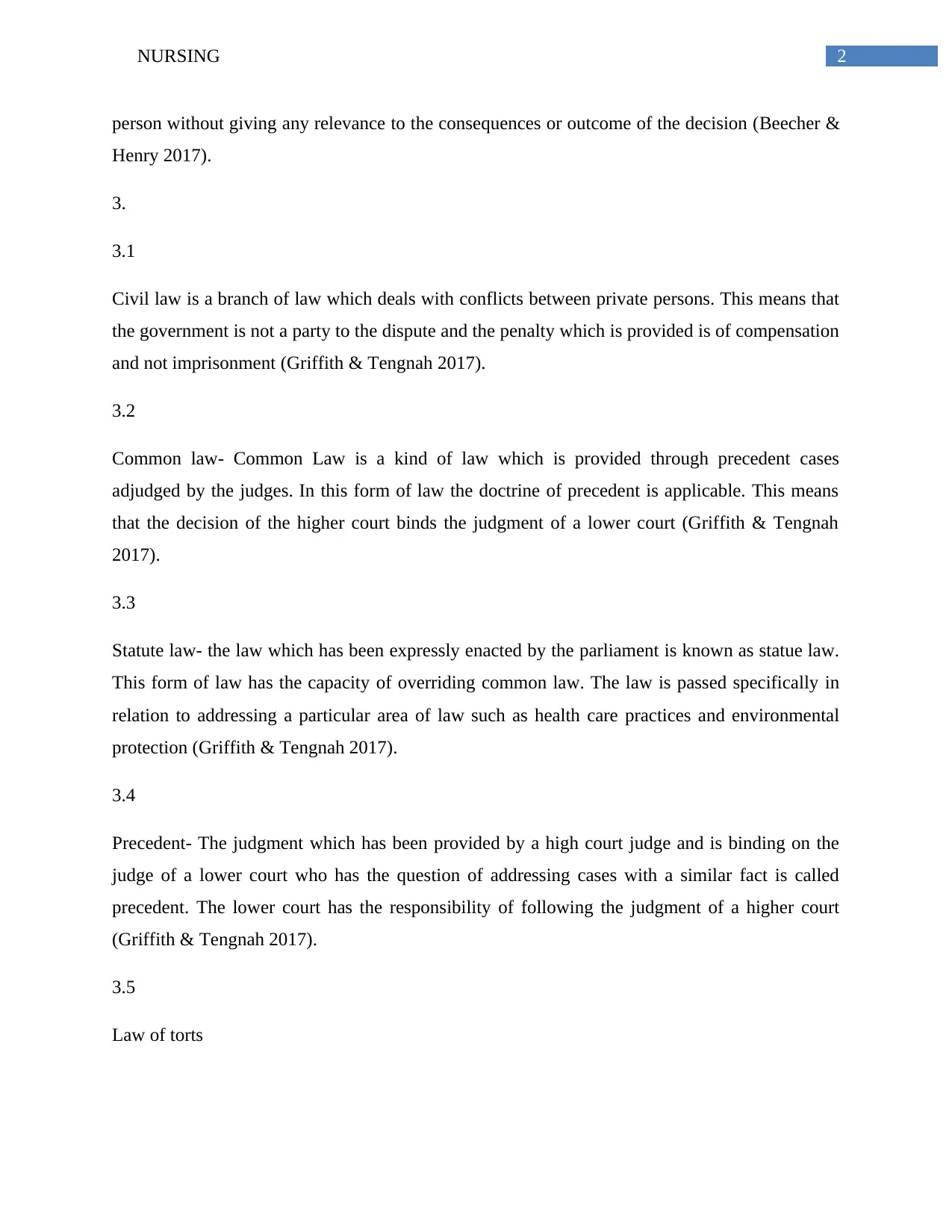
2NURSING
person without giving any relevance to the consequences or outcome of the decision (Beecher &
Henry 2017).
3.
3.1
Civil law is a branch of law which deals with conflicts between private persons. This means that
the government is not a party to the dispute and the penalty which is provided is of compensation
and not imprisonment (Griffith & Tengnah 2017).
3.2
Common law- Common Law is a kind of law which is provided through precedent cases
adjudged by the judges. In this form of law the doctrine of precedent is applicable. This means
that the decision of the higher court binds the judgment of a lower court (Griffith & Tengnah
2017).
3.3
Statute law- the law which has been expressly enacted by the parliament is known as statue law.
This form of law has the capacity of overriding common law. The law is passed specifically in
relation to addressing a particular area of law such as health care practices and environmental
protection (Griffith & Tengnah 2017).
3.4
Precedent- The judgment which has been provided by a high court judge and is binding on the
judge of a lower court who has the question of addressing cases with a similar fact is called
precedent. The lower court has the responsibility of following the judgment of a higher court
(Griffith & Tengnah 2017).
3.5
Law of torts
person without giving any relevance to the consequences or outcome of the decision (Beecher &
Henry 2017).
3.
3.1
Civil law is a branch of law which deals with conflicts between private persons. This means that
the government is not a party to the dispute and the penalty which is provided is of compensation
and not imprisonment (Griffith & Tengnah 2017).
3.2
Common law- Common Law is a kind of law which is provided through precedent cases
adjudged by the judges. In this form of law the doctrine of precedent is applicable. This means
that the decision of the higher court binds the judgment of a lower court (Griffith & Tengnah
2017).
3.3
Statute law- the law which has been expressly enacted by the parliament is known as statue law.
This form of law has the capacity of overriding common law. The law is passed specifically in
relation to addressing a particular area of law such as health care practices and environmental
protection (Griffith & Tengnah 2017).
3.4
Precedent- The judgment which has been provided by a high court judge and is binding on the
judge of a lower court who has the question of addressing cases with a similar fact is called
precedent. The lower court has the responsibility of following the judgment of a higher court
(Griffith & Tengnah 2017).
3.5
Law of torts
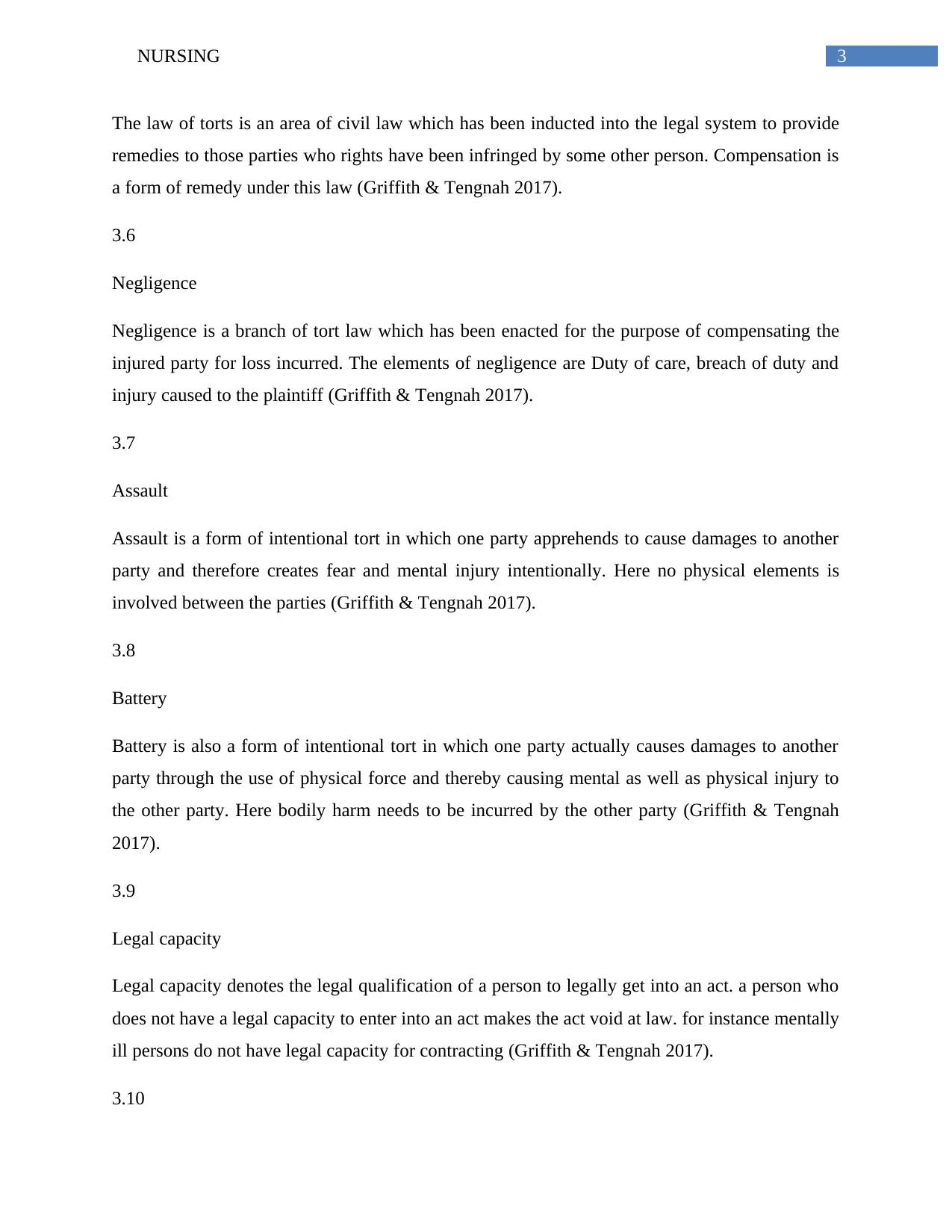
3NURSING
The law of torts is an area of civil law which has been inducted into the legal system to provide
remedies to those parties who rights have been infringed by some other person. Compensation is
a form of remedy under this law (Griffith & Tengnah 2017).
3.6
Negligence
Negligence is a branch of tort law which has been enacted for the purpose of compensating the
injured party for loss incurred. The elements of negligence are Duty of care, breach of duty and
injury caused to the plaintiff (Griffith & Tengnah 2017).
3.7
Assault
Assault is a form of intentional tort in which one party apprehends to cause damages to another
party and therefore creates fear and mental injury intentionally. Here no physical elements is
involved between the parties (Griffith & Tengnah 2017).
3.8
Battery
Battery is also a form of intentional tort in which one party actually causes damages to another
party through the use of physical force and thereby causing mental as well as physical injury to
the other party. Here bodily harm needs to be incurred by the other party (Griffith & Tengnah
2017).
3.9
Legal capacity
Legal capacity denotes the legal qualification of a person to legally get into an act. a person who
does not have a legal capacity to enter into an act makes the act void at law. for instance mentally
ill persons do not have legal capacity for contracting (Griffith & Tengnah 2017).
3.10
The law of torts is an area of civil law which has been inducted into the legal system to provide
remedies to those parties who rights have been infringed by some other person. Compensation is
a form of remedy under this law (Griffith & Tengnah 2017).
3.6
Negligence
Negligence is a branch of tort law which has been enacted for the purpose of compensating the
injured party for loss incurred. The elements of negligence are Duty of care, breach of duty and
injury caused to the plaintiff (Griffith & Tengnah 2017).
3.7
Assault
Assault is a form of intentional tort in which one party apprehends to cause damages to another
party and therefore creates fear and mental injury intentionally. Here no physical elements is
involved between the parties (Griffith & Tengnah 2017).
3.8
Battery
Battery is also a form of intentional tort in which one party actually causes damages to another
party through the use of physical force and thereby causing mental as well as physical injury to
the other party. Here bodily harm needs to be incurred by the other party (Griffith & Tengnah
2017).
3.9
Legal capacity
Legal capacity denotes the legal qualification of a person to legally get into an act. a person who
does not have a legal capacity to enter into an act makes the act void at law. for instance mentally
ill persons do not have legal capacity for contracting (Griffith & Tengnah 2017).
3.10
Secure Best Marks with AI Grader
Need help grading? Try our AI Grader for instant feedback on your assignments.
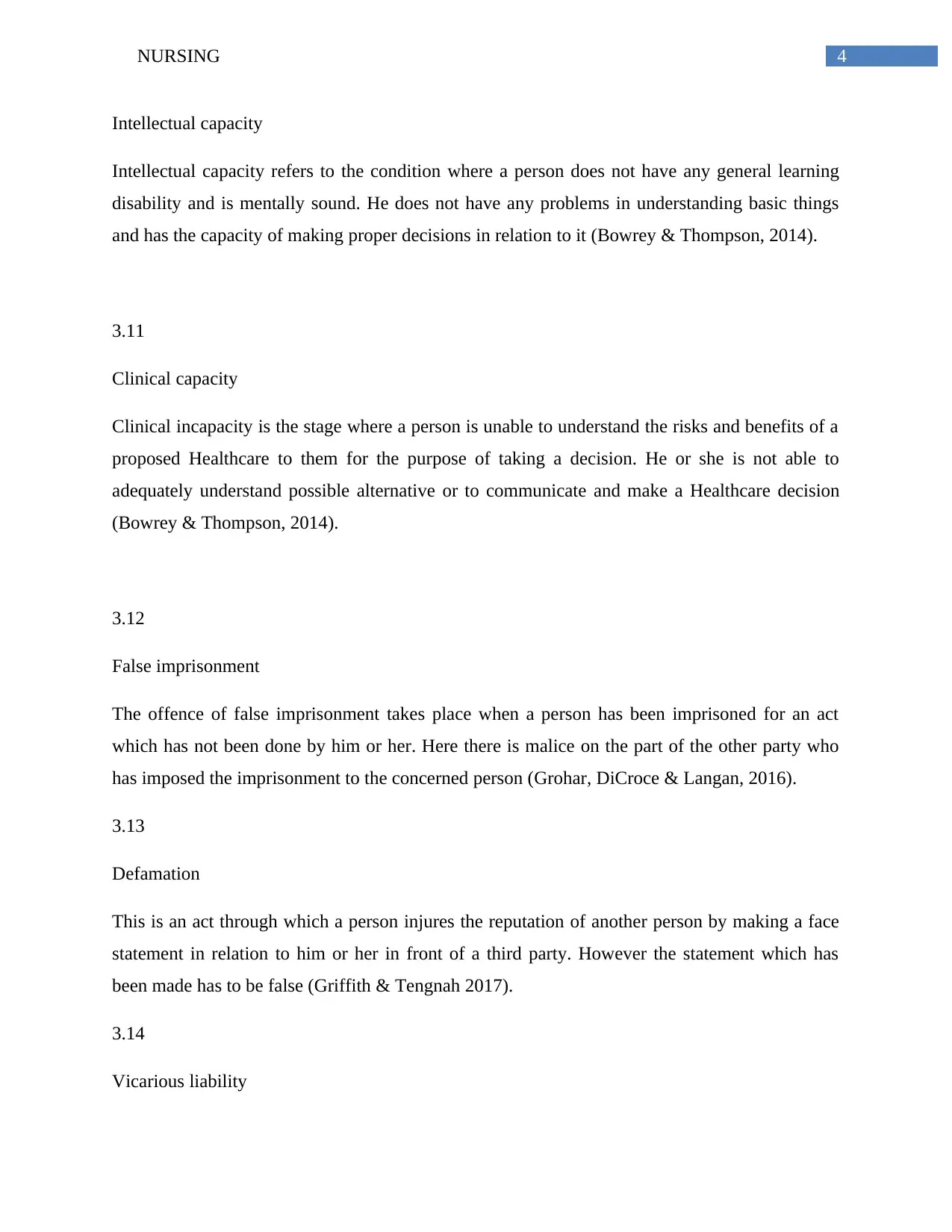
4NURSING
Intellectual capacity
Intellectual capacity refers to the condition where a person does not have any general learning
disability and is mentally sound. He does not have any problems in understanding basic things
and has the capacity of making proper decisions in relation to it (Bowrey & Thompson, 2014).
3.11
Clinical capacity
Clinical incapacity is the stage where a person is unable to understand the risks and benefits of a
proposed Healthcare to them for the purpose of taking a decision. He or she is not able to
adequately understand possible alternative or to communicate and make a Healthcare decision
(Bowrey & Thompson, 2014).
3.12
False imprisonment
The offence of false imprisonment takes place when a person has been imprisoned for an act
which has not been done by him or her. Here there is malice on the part of the other party who
has imposed the imprisonment to the concerned person (Grohar, DiCroce & Langan, 2016).
3.13
Defamation
This is an act through which a person injures the reputation of another person by making a face
statement in relation to him or her in front of a third party. However the statement which has
been made has to be false (Griffith & Tengnah 2017).
3.14
Vicarious liability
Intellectual capacity
Intellectual capacity refers to the condition where a person does not have any general learning
disability and is mentally sound. He does not have any problems in understanding basic things
and has the capacity of making proper decisions in relation to it (Bowrey & Thompson, 2014).
3.11
Clinical capacity
Clinical incapacity is the stage where a person is unable to understand the risks and benefits of a
proposed Healthcare to them for the purpose of taking a decision. He or she is not able to
adequately understand possible alternative or to communicate and make a Healthcare decision
(Bowrey & Thompson, 2014).
3.12
False imprisonment
The offence of false imprisonment takes place when a person has been imprisoned for an act
which has not been done by him or her. Here there is malice on the part of the other party who
has imposed the imprisonment to the concerned person (Grohar, DiCroce & Langan, 2016).
3.13
Defamation
This is an act through which a person injures the reputation of another person by making a face
statement in relation to him or her in front of a third party. However the statement which has
been made has to be false (Griffith & Tengnah 2017).
3.14
Vicarious liability

5NURSING
This is a principles through which the present law makes the master liable for the actions which
has been done by the servant. Any act which has been done by the agent on behalf of the
principal is binding on the principal (Griffith & Tengnah 2017).
3.15
Defendant
The defendant at law is a person against whom an action has been brought in the court by the
plaintiff. This person has the duty of defending the claim which has been brought against him by
the plaintiff in the court (Griffith & Tengnah 2017).
3.16
Plaintiff
The plaintiff is a person who initiates a legal action against the defendant for allegedly causing
injury to him or her against the breach of law. The plaintiff has to prove that the defendant has
breach the law and caused injury (Griffith & Tengnah 2017).
3.17
Harassment
Harassment is an act which takes place when one person causes problem to another by doing
actions which have not been consented and caused mental harm to the person who has been
subjected to harassment (Griffith & Tengnah 2017).
3.18
Expert witness
Expert witness are those who have specific knowledge in relation to a particular matter (Griffith
& Tengnah 2017).
3.19
Coronial inquest
This is a principles through which the present law makes the master liable for the actions which
has been done by the servant. Any act which has been done by the agent on behalf of the
principal is binding on the principal (Griffith & Tengnah 2017).
3.15
Defendant
The defendant at law is a person against whom an action has been brought in the court by the
plaintiff. This person has the duty of defending the claim which has been brought against him by
the plaintiff in the court (Griffith & Tengnah 2017).
3.16
Plaintiff
The plaintiff is a person who initiates a legal action against the defendant for allegedly causing
injury to him or her against the breach of law. The plaintiff has to prove that the defendant has
breach the law and caused injury (Griffith & Tengnah 2017).
3.17
Harassment
Harassment is an act which takes place when one person causes problem to another by doing
actions which have not been consented and caused mental harm to the person who has been
subjected to harassment (Griffith & Tengnah 2017).
3.18
Expert witness
Expert witness are those who have specific knowledge in relation to a particular matter (Griffith
& Tengnah 2017).
3.19
Coronial inquest
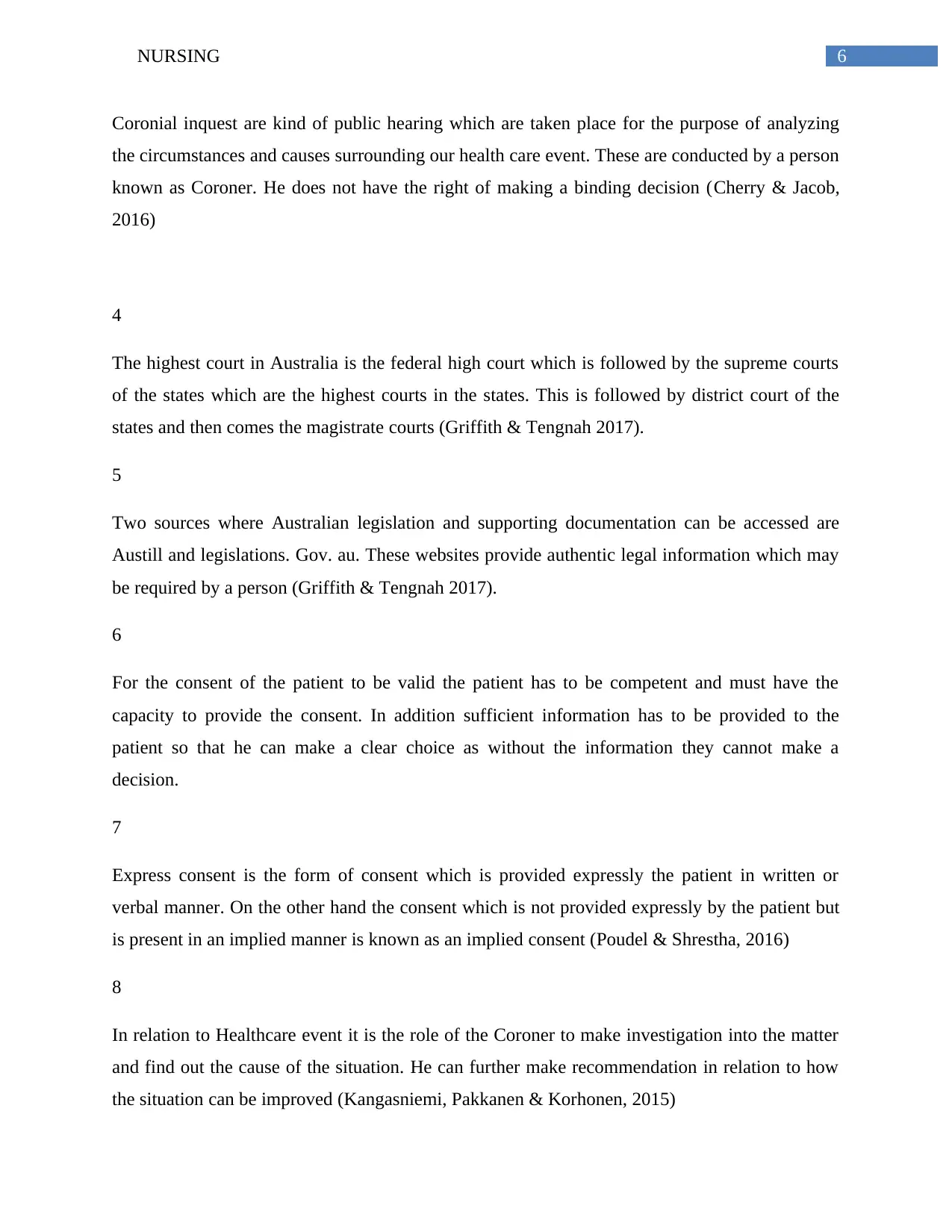
6NURSING
Coronial inquest are kind of public hearing which are taken place for the purpose of analyzing
the circumstances and causes surrounding our health care event. These are conducted by a person
known as Coroner. He does not have the right of making a binding decision (Cherry & Jacob,
2016)
4
The highest court in Australia is the federal high court which is followed by the supreme courts
of the states which are the highest courts in the states. This is followed by district court of the
states and then comes the magistrate courts (Griffith & Tengnah 2017).
5
Two sources where Australian legislation and supporting documentation can be accessed are
Austill and legislations. Gov. au. These websites provide authentic legal information which may
be required by a person (Griffith & Tengnah 2017).
6
For the consent of the patient to be valid the patient has to be competent and must have the
capacity to provide the consent. In addition sufficient information has to be provided to the
patient so that he can make a clear choice as without the information they cannot make a
decision.
7
Express consent is the form of consent which is provided expressly the patient in written or
verbal manner. On the other hand the consent which is not provided expressly by the patient but
is present in an implied manner is known as an implied consent (Poudel & Shrestha, 2016)
8
In relation to Healthcare event it is the role of the Coroner to make investigation into the matter
and find out the cause of the situation. He can further make recommendation in relation to how
the situation can be improved (Kangasniemi, Pakkanen & Korhonen, 2015)
Coronial inquest are kind of public hearing which are taken place for the purpose of analyzing
the circumstances and causes surrounding our health care event. These are conducted by a person
known as Coroner. He does not have the right of making a binding decision (Cherry & Jacob,
2016)
4
The highest court in Australia is the federal high court which is followed by the supreme courts
of the states which are the highest courts in the states. This is followed by district court of the
states and then comes the magistrate courts (Griffith & Tengnah 2017).
5
Two sources where Australian legislation and supporting documentation can be accessed are
Austill and legislations. Gov. au. These websites provide authentic legal information which may
be required by a person (Griffith & Tengnah 2017).
6
For the consent of the patient to be valid the patient has to be competent and must have the
capacity to provide the consent. In addition sufficient information has to be provided to the
patient so that he can make a clear choice as without the information they cannot make a
decision.
7
Express consent is the form of consent which is provided expressly the patient in written or
verbal manner. On the other hand the consent which is not provided expressly by the patient but
is present in an implied manner is known as an implied consent (Poudel & Shrestha, 2016)
8
In relation to Healthcare event it is the role of the Coroner to make investigation into the matter
and find out the cause of the situation. He can further make recommendation in relation to how
the situation can be improved (Kangasniemi, Pakkanen & Korhonen, 2015)
Paraphrase This Document
Need a fresh take? Get an instant paraphrase of this document with our AI Paraphraser
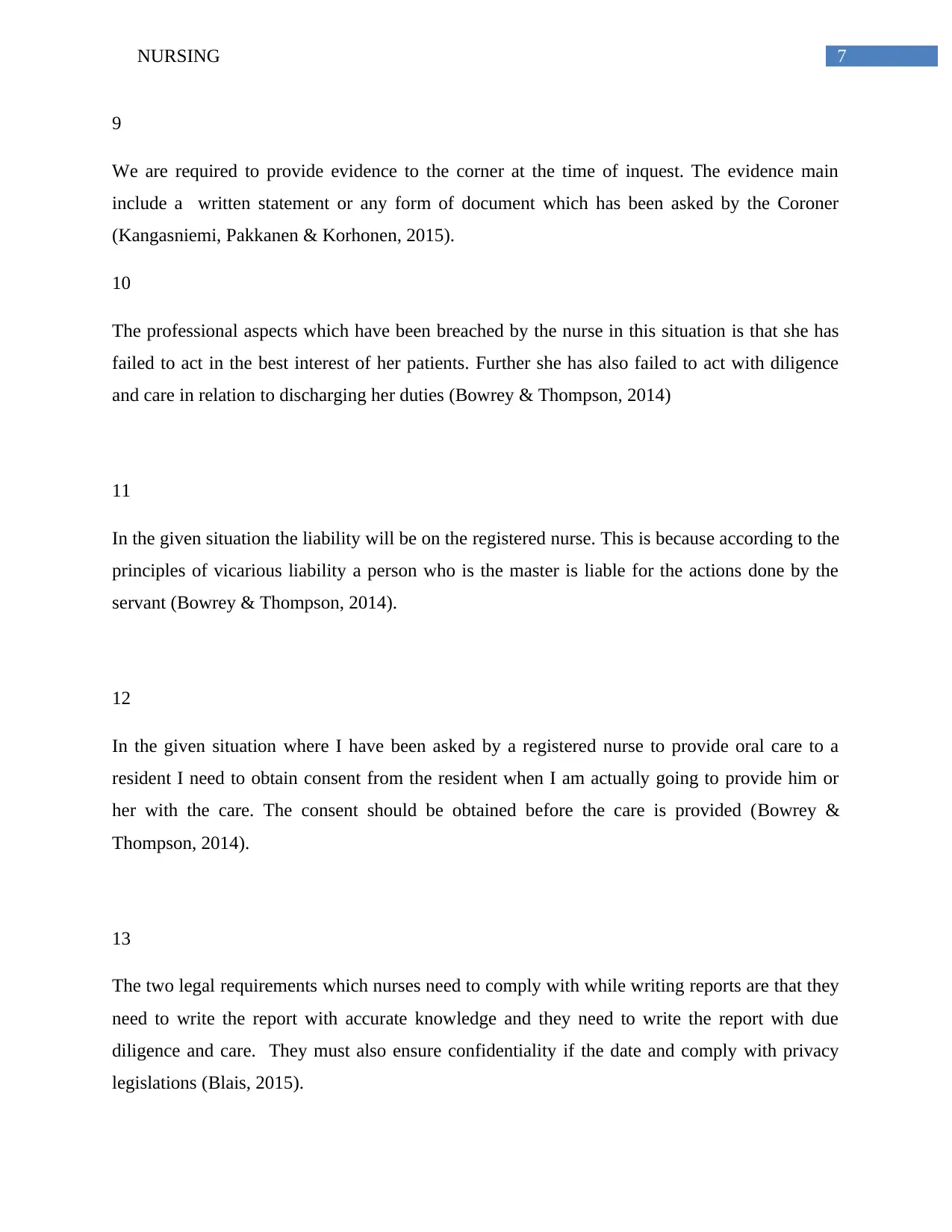
7NURSING
9
We are required to provide evidence to the corner at the time of inquest. The evidence main
include a written statement or any form of document which has been asked by the Coroner
(Kangasniemi, Pakkanen & Korhonen, 2015).
10
The professional aspects which have been breached by the nurse in this situation is that she has
failed to act in the best interest of her patients. Further she has also failed to act with diligence
and care in relation to discharging her duties (Bowrey & Thompson, 2014)
11
In the given situation the liability will be on the registered nurse. This is because according to the
principles of vicarious liability a person who is the master is liable for the actions done by the
servant (Bowrey & Thompson, 2014).
12
In the given situation where I have been asked by a registered nurse to provide oral care to a
resident I need to obtain consent from the resident when I am actually going to provide him or
her with the care. The consent should be obtained before the care is provided (Bowrey &
Thompson, 2014).
13
The two legal requirements which nurses need to comply with while writing reports are that they
need to write the report with accurate knowledge and they need to write the report with due
diligence and care. They must also ensure confidentiality if the date and comply with privacy
legislations (Blais, 2015).
9
We are required to provide evidence to the corner at the time of inquest. The evidence main
include a written statement or any form of document which has been asked by the Coroner
(Kangasniemi, Pakkanen & Korhonen, 2015).
10
The professional aspects which have been breached by the nurse in this situation is that she has
failed to act in the best interest of her patients. Further she has also failed to act with diligence
and care in relation to discharging her duties (Bowrey & Thompson, 2014)
11
In the given situation the liability will be on the registered nurse. This is because according to the
principles of vicarious liability a person who is the master is liable for the actions done by the
servant (Bowrey & Thompson, 2014).
12
In the given situation where I have been asked by a registered nurse to provide oral care to a
resident I need to obtain consent from the resident when I am actually going to provide him or
her with the care. The consent should be obtained before the care is provided (Bowrey &
Thompson, 2014).
13
The two legal requirements which nurses need to comply with while writing reports are that they
need to write the report with accurate knowledge and they need to write the report with due
diligence and care. They must also ensure confidentiality if the date and comply with privacy
legislations (Blais, 2015).
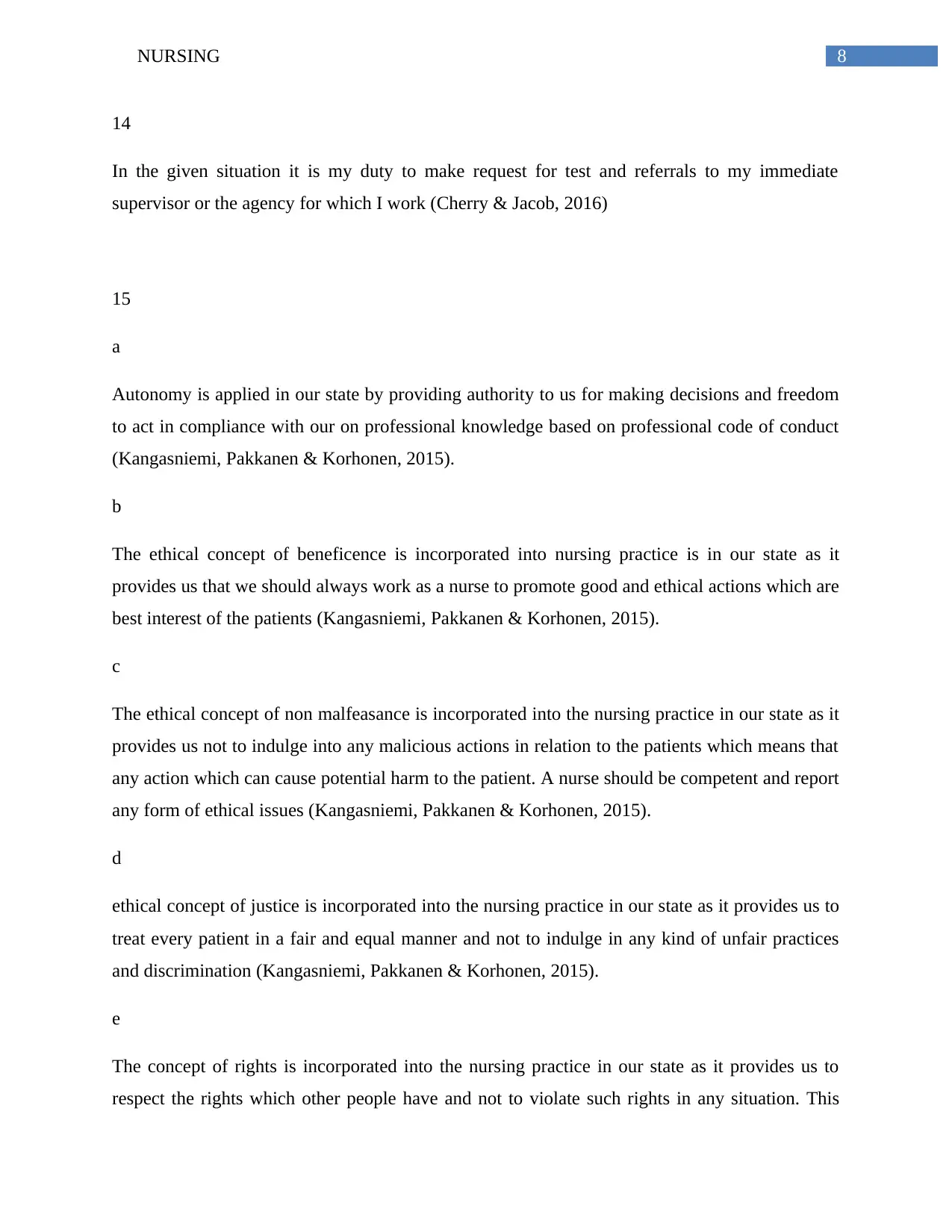
8NURSING
14
In the given situation it is my duty to make request for test and referrals to my immediate
supervisor or the agency for which I work (Cherry & Jacob, 2016)
15
a
Autonomy is applied in our state by providing authority to us for making decisions and freedom
to act in compliance with our on professional knowledge based on professional code of conduct
(Kangasniemi, Pakkanen & Korhonen, 2015).
b
The ethical concept of beneficence is incorporated into nursing practice is in our state as it
provides us that we should always work as a nurse to promote good and ethical actions which are
best interest of the patients (Kangasniemi, Pakkanen & Korhonen, 2015).
c
The ethical concept of non malfeasance is incorporated into the nursing practice in our state as it
provides us not to indulge into any malicious actions in relation to the patients which means that
any action which can cause potential harm to the patient. A nurse should be competent and report
any form of ethical issues (Kangasniemi, Pakkanen & Korhonen, 2015).
d
ethical concept of justice is incorporated into the nursing practice in our state as it provides us to
treat every patient in a fair and equal manner and not to indulge in any kind of unfair practices
and discrimination (Kangasniemi, Pakkanen & Korhonen, 2015).
e
The concept of rights is incorporated into the nursing practice in our state as it provides us to
respect the rights which other people have and not to violate such rights in any situation. This
14
In the given situation it is my duty to make request for test and referrals to my immediate
supervisor or the agency for which I work (Cherry & Jacob, 2016)
15
a
Autonomy is applied in our state by providing authority to us for making decisions and freedom
to act in compliance with our on professional knowledge based on professional code of conduct
(Kangasniemi, Pakkanen & Korhonen, 2015).
b
The ethical concept of beneficence is incorporated into nursing practice is in our state as it
provides us that we should always work as a nurse to promote good and ethical actions which are
best interest of the patients (Kangasniemi, Pakkanen & Korhonen, 2015).
c
The ethical concept of non malfeasance is incorporated into the nursing practice in our state as it
provides us not to indulge into any malicious actions in relation to the patients which means that
any action which can cause potential harm to the patient. A nurse should be competent and report
any form of ethical issues (Kangasniemi, Pakkanen & Korhonen, 2015).
d
ethical concept of justice is incorporated into the nursing practice in our state as it provides us to
treat every patient in a fair and equal manner and not to indulge in any kind of unfair practices
and discrimination (Kangasniemi, Pakkanen & Korhonen, 2015).
e
The concept of rights is incorporated into the nursing practice in our state as it provides us to
respect the rights which other people have and not to violate such rights in any situation. This
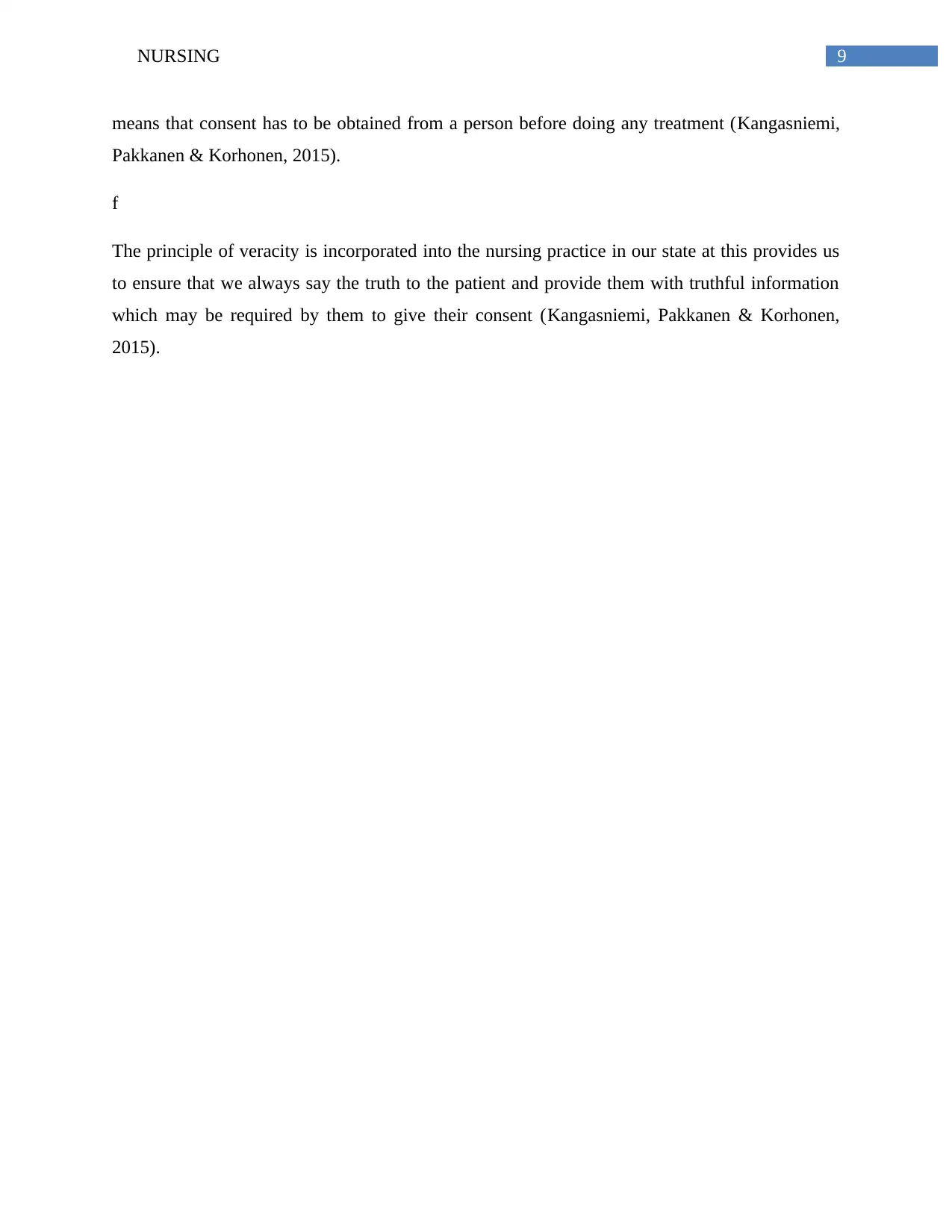
9NURSING
means that consent has to be obtained from a person before doing any treatment (Kangasniemi,
Pakkanen & Korhonen, 2015).
f
The principle of veracity is incorporated into the nursing practice in our state at this provides us
to ensure that we always say the truth to the patient and provide them with truthful information
which may be required by them to give their consent (Kangasniemi, Pakkanen & Korhonen,
2015).
means that consent has to be obtained from a person before doing any treatment (Kangasniemi,
Pakkanen & Korhonen, 2015).
f
The principle of veracity is incorporated into the nursing practice in our state at this provides us
to ensure that we always say the truth to the patient and provide them with truthful information
which may be required by them to give their consent (Kangasniemi, Pakkanen & Korhonen,
2015).
Secure Best Marks with AI Grader
Need help grading? Try our AI Grader for instant feedback on your assignments.
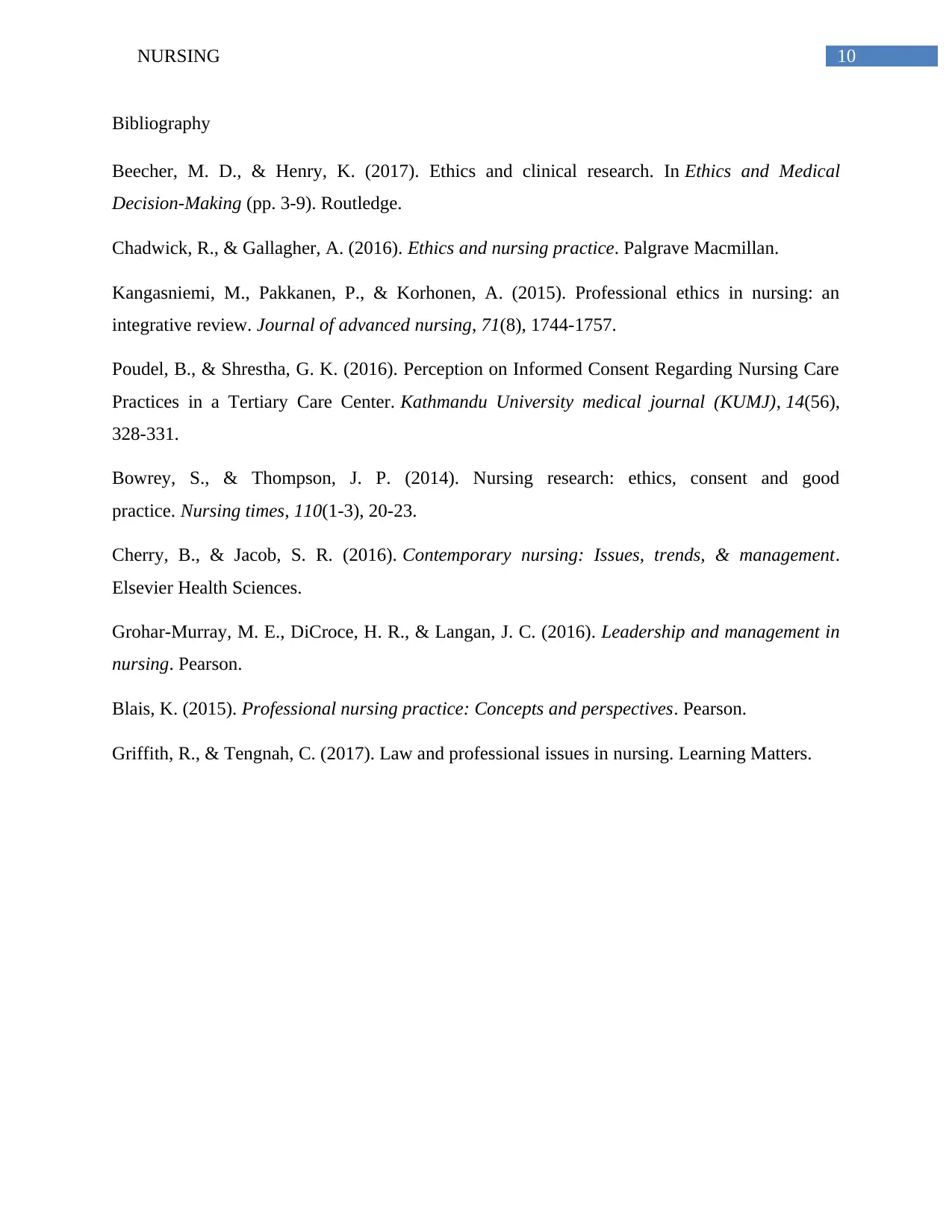
10NURSING
Bibliography
Beecher, M. D., & Henry, K. (2017). Ethics and clinical research. In Ethics and Medical
Decision-Making (pp. 3-9). Routledge.
Chadwick, R., & Gallagher, A. (2016). Ethics and nursing practice. Palgrave Macmillan.
Kangasniemi, M., Pakkanen, P., & Korhonen, A. (2015). Professional ethics in nursing: an
integrative review. Journal of advanced nursing, 71(8), 1744-1757.
Poudel, B., & Shrestha, G. K. (2016). Perception on Informed Consent Regarding Nursing Care
Practices in a Tertiary Care Center. Kathmandu University medical journal (KUMJ), 14(56),
328-331.
Bowrey, S., & Thompson, J. P. (2014). Nursing research: ethics, consent and good
practice. Nursing times, 110(1-3), 20-23.
Cherry, B., & Jacob, S. R. (2016). Contemporary nursing: Issues, trends, & management.
Elsevier Health Sciences.
Grohar-Murray, M. E., DiCroce, H. R., & Langan, J. C. (2016). Leadership and management in
nursing. Pearson.
Blais, K. (2015). Professional nursing practice: Concepts and perspectives. Pearson.
Griffith, R., & Tengnah, C. (2017). Law and professional issues in nursing. Learning Matters.
Bibliography
Beecher, M. D., & Henry, K. (2017). Ethics and clinical research. In Ethics and Medical
Decision-Making (pp. 3-9). Routledge.
Chadwick, R., & Gallagher, A. (2016). Ethics and nursing practice. Palgrave Macmillan.
Kangasniemi, M., Pakkanen, P., & Korhonen, A. (2015). Professional ethics in nursing: an
integrative review. Journal of advanced nursing, 71(8), 1744-1757.
Poudel, B., & Shrestha, G. K. (2016). Perception on Informed Consent Regarding Nursing Care
Practices in a Tertiary Care Center. Kathmandu University medical journal (KUMJ), 14(56),
328-331.
Bowrey, S., & Thompson, J. P. (2014). Nursing research: ethics, consent and good
practice. Nursing times, 110(1-3), 20-23.
Cherry, B., & Jacob, S. R. (2016). Contemporary nursing: Issues, trends, & management.
Elsevier Health Sciences.
Grohar-Murray, M. E., DiCroce, H. R., & Langan, J. C. (2016). Leadership and management in
nursing. Pearson.
Blais, K. (2015). Professional nursing practice: Concepts and perspectives. Pearson.
Griffith, R., & Tengnah, C. (2017). Law and professional issues in nursing. Learning Matters.
1 out of 11
Related Documents
Your All-in-One AI-Powered Toolkit for Academic Success.
+13062052269
info@desklib.com
Available 24*7 on WhatsApp / Email
![[object Object]](/_next/static/media/star-bottom.7253800d.svg)
Unlock your academic potential
© 2024 | Zucol Services PVT LTD | All rights reserved.



